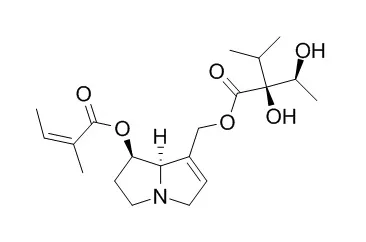| Structure Identification: |
| Phytochem Anal. 2011 Nov-Dec;22(6):532-40. | | Detection of high levels of pyrrolizidine-N-oxides in the endangered plant Cryptantha crassipes (Terlingua Creek cat's-eye) using HPLC-ESI-MS.[Pubmed: 21433162] | A previous investigation of pyrrolizidine alkaloids produced by nine species of Cryptantha identified at least two chemotypes within the genus. Other research has postulated that pyrrolizidine-N-oxide concentrations increase as the growing conditions become harsher, particularly with respect to water availability. Cryptantha crassipes is an endangered plant with a very limited distribution range within a dry, harsh Texan ecosystem.
To determine the pyrrolizidine alkaloid (and their N-oxides) profile and concentrations in Cryptantha crassipes.
METHODS AND RESULTS:
Methanolic extracts of Cryptantha crassipes were partitioned into dilute sulphuric acid and the alkaloids concentrated using strong cation exchange, solid-phase extraction columns. Extracts were analysed using reversed-phase high-pressure liquid chromatography coupled to electrospray ionisation ion trap mass spectrometry.
The N-oxides of lycopsamine and intermedine were the major pyrrolizidine alkaloids detected in Cryptantha crassipes. Smaller to trace amounts of other pyrrolizidine alkaloids observed were: the 7- and 3'-acetylated derivatives and the 1,2-dihydro analogs of lycopsamine-N-oxide and/or intermedine-N-oxide; a pair of unidentified N-oxides, isobaric with lycopsamine-N-oxide; and the N-oxides of leptanthine, echimiplatine, amabiline, Echiumine and dihydroEchiumine. Only trace amounts, if any, of the parent free base pyrrolizidine alkaloids were detected. The concentration of pyrrolizidine alkaloids was estimated to be 3-5% of the dry weight of milled leaves, or 10-50 times the levels previously reported for similar chemotypes.
CONCLUSIONS:
The high levels of the N-oxides of lycopsamine and intermedine establish the genus chemotype of the endangered Cryptantha crassipes and support earlier data linking high levels of N-oxides to dry, harsh growing conditions.
|
|






 Cell. 2018 Jan 11;172(1-2):249-261.e12. doi: 10.1016/j.cell.2017.12.019.IF=36.216(2019)
Cell. 2018 Jan 11;172(1-2):249-261.e12. doi: 10.1016/j.cell.2017.12.019.IF=36.216(2019) Cell Metab. 2020 Mar 3;31(3):534-548.e5. doi: 10.1016/j.cmet.2020.01.002.IF=22.415(2019)
Cell Metab. 2020 Mar 3;31(3):534-548.e5. doi: 10.1016/j.cmet.2020.01.002.IF=22.415(2019) Mol Cell. 2017 Nov 16;68(4):673-685.e6. doi: 10.1016/j.molcel.2017.10.022.IF=14.548(2019)
Mol Cell. 2017 Nov 16;68(4):673-685.e6. doi: 10.1016/j.molcel.2017.10.022.IF=14.548(2019)